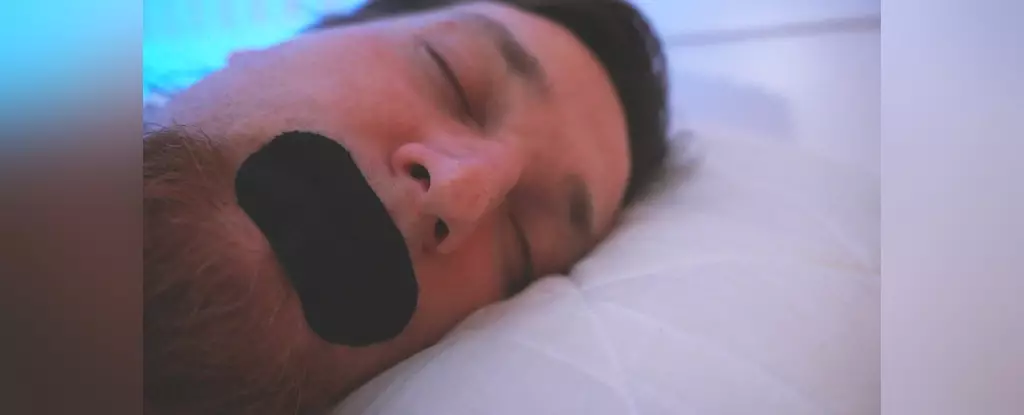In the quest for a restful night’s sleep, many individuals and couples have turned to unconventional methods as solutions to sleep disturbances. Among these is the social media trend of ‘mouth taping,’ a practice where users seal their mouths with medical tape during sleep to mitigate the effects of mouth breathing. This trend, fueled by countless TikTok videos showcasing influencers purportedly reaping a plethora of benefits—ranging from improved jaw aesthetics to heightened energy levels—has captivated a large audience. However, beneath the glitz of viral fame lies an urgent need for scientific rigor and critical evaluation.
The premise behind mouth taping rests on the belief that encouraging nasal breathing can resolve issues such as snoring and obstructive sleep apnea. While these assertions may seem compelling, they beckon skepticism. How many of us have fallen prey to quick fixes promising transformative results without substantial evidence? It becomes increasingly crucial to dissect the validity of such claims provided by social media influencers who may misrepresent facts to gain traction.
The Science Behind Mouth Breathing
Mouth breathing during sleep is commonly associated with various conditions, including obstructive sleep apnea, sinus infections, or anatomical blockages such as a deviated septum or nasal polyps. When one chews over the prospect of sealing their mouth shut to remedy these underlying issues, it becomes readily apparent that such a solution might merely serve to mask symptoms without addressing root causes. This nonsensical cycle raises critical questions about the efficacy of mouth taping as a remedy.
Indeed, the scant body of scientific literature on mouth taping reveals a troubling narrative. While some minimal studies indicate potential improvements in mild cases of obstructive sleep apnea—measurable through indices like the apnea-hypopnea index—these findings are far from conclusive. A deeper dive into existing research exposes a glaring absence of robust evidence supporting the widespread claims associated with mouth taping. Notably, many studies suffer from methodological flaws: lack of long-term follow-up, non-representative sample sizes, and insufficient control for confounding variables make these findings unreliable.
Potential Risks and Misguided Solutions
Perhaps the most alarming aspect of promoting mouth taping is the potential health risks involved. Research indicates that for individuals with nasal obstructions, sealing the mouth can lead to life-threatening situations like asphyxiation. Rather than facilitating improved breathing, mouth taping can inadvertently worsen conditions for those who may already be grappling with compromised respiratory systems. It becomes evident that band-aid solutions can distract from meaningful treatment and curative practices that address the fundamental issues at play.
Moreover, patients desperate for relief might find themselves delaying necessary medical intervention by buying into the mirage of quick fixes. Symptoms of sleep apnea and other sleep disorders are complex and diverse, requiring nuanced treatment approaches rather than one-size-fits-all methods. Relying on mouth taping as a primary solution not only undermines legitimate pathways to health but could also exacerbate existing conditions.
The Need for Comprehensive Sleep Health Solutions
Ultimately, if mouth breathing or sleep disruptions are preventing you or your partner from obtaining a full night’s rest, the answer lies not on social media platforms but in consulting health professionals. Personalized assessment and treatment are critical in managing sleep-related disorders effectively. Physicians can provide tailored strategies, ranging from behavioral therapies that address sleep habits to medical interventions for those suffering from significant anatomical obstructions.
As more individuals turn to social media for advice on serious health matters, a balance between innovative solutions and scientific validation must be sought. While emerging trends like mouth taping may present intriguing possibilities, individuals must remain vigilant and discerning in separating possibility from reality. The conversation surrounding sleep health deserves depth, nuance, and science-based discourse rather than superficial remedies tossed around in trending hashtags.
Skip the tape, book that appointment, and invest in your well-being. True restful sleep is not a trend but a priceless commodity that requires due diligence in seeking effective and safe solutions.

